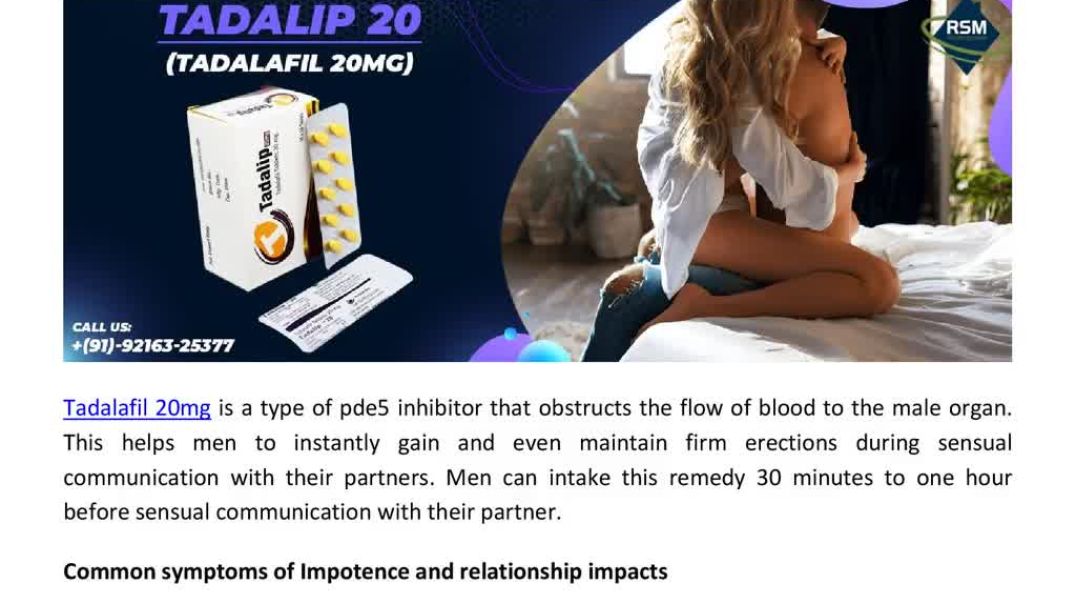Top videos
Watch that Functional Neck Dissection Surgery
Watch that video of an Ingrown hair turns into 140-pound tumor in man’s stomach
Watch that video of Black and Whiteheads on Nose Removal
MaxGun Sublingual Spray is a cutting-edge solution containing Sildenafil Spray Sublingual, designed to enhance male vitality discreetly and effectively. MaxGun Sublingual Spray offers a discreet solution for those seeking heightened sexual experiences.
Chat on WhatsApp with +91 92163-25377
Buy Now : https://www.rsmenterprises.in/....product/viewdetail/m
#rsmenterprises #health #healthcare #sildenafilsublingualspray #maxgunsublingualspray #genericviagraspray #edmedicine
Endovascular Aneurysm Repair Endovascular aneurysm repair (or endovascular aortic repair) (EVAR) is a type of endovascular surgery used to treat pathology of the aorta, most commonly an abdominal aortic aneurysm (AAA).
Tadalip 20 is an efficient medicine that helps resolve the problem of Erectile Dysfunction. It comprises Tadalafil 20mg as an active component. The manufacturing of the medicine is done for RSM Enterprises.
Buy Now : https://www.rsmenterprises.in/....product/viewdetail/t
#rsmenterprises #health #healthcare #tadalip20mg #tadalafil20mg #genericcialis #malecialis #edmedicine
Bimat 3ml (Bimatprost Opthalmic Solution) is an effective solution to resolve the problem of Glaucoma. It comes with an active substance of Bimatprost Opthalmic Solution 3ml.
Buy Now : https://www.rsmenterprises.in/....product/viewdetail/b
#rsmenterprises #health #healthcare #bimat3ml #bimateyedrop #bimatprosteyedrop #eyedrop
Because Doctors must give all to their patients!
Sildigra Super Power (Sildenafil 100mg + Dapoxetine 60mg) is the first product on the market which is designed to remedy two male dysfunctions in one. Commonly the Sildenafil 100mg+Dapoxetine 60mg Tablets are prescribed for male erectile dysfunction and premature ejaculation.
Buy Now : https://www.rsmenterprises.in/....product/viewdetail/s
#rsmenterprises #health #healthcare #sildigrasuperpower #sildenafil100mg #dapoxetine60mg #edmedicine #genericviagra
Closed Reduction of Distal Radius Fractures - Discussion: (distal radius fracture menu) - closed reduction & immobilization in plaster cast remains accepted method of treatment for majority of stable distal radius frx; - unstable fractures will often lose reduction in the cast and will slip back to the pre-reduction position; - patients should be examined for carpal tunnel symptoms before and after reduction; - carpal tunnel symptoms that do not resolve following reduction will require carpal tunnel release; - cautions: - The efficacy of closed reduction in displaced distal radius fractures. - Technique: - anesthesia: (see: anesthesia menu) - hematoma block w/ lidocaine; - w/ hematoma block surgeon should look for "flash back" of blood from hematoma, prior to injection; - references: - Regional anesthesia preferable for Colles' fracture. Controlled comparison with local anesthesia. - Neurological complications of dynamic reduction of Colles' fractures without anesthesia compared with traditional manipulation after local infiltration anesthesia. - methods of reduction: - Jones method: involves increasing deformity, applying traction, and immobilizing hand & wrist in reduced position; - placing hand & wrist in too much flexion (Cotton-Loder position) leads to median nerve compression & stiff fingers; - Bohler advocated longitudinal traction followed by extension and realignment; - consider hyper-extending the distal fragment, and then translating it distally (while in extended position) until it can be "hooked over" proximal fragment; - subsequently, the distal fragment can be flexed (or hinged) over the proximal shaft fragment; - closed reduction of distal radius fractures is facilitated by having an assistant provide counter traction (above the elbow) while the surgeon controls the distal fragment w/ both hands (both thumbs over the dorsal surface of the distal fragment); - flouroscopy: - it allows a quick, gentle, and complete reduction; - prepare are by prewrapping the arm w/ sheet cotton and have the plaster or fibroglass ready; - if flouroscopy is not available, then do not pre-wrap the extremity w/ cotton; - it will be necessary to palpate the landmarks (outer shaped of radius, radial styloid, and Lister's tubercle, in order to judge success of reduction; - casting: - generally, the surgeon will use a pre-measured double sugar sugar tong splint, which is 6-8 layers in thickness; - more than 8 layers of plaster can cause full thickness burns: - reference: Setting temperatures of synthetic casts. - position of immobilization - follow up: - radiographs: - repeat radiographs are required weekly for 2-3 weeks to ensure that there is maintenance of the reduction; - a fracture reduction that slips should be considered to be unstable and probably require fixation with (pins, or ex fix ect.) - there is some evidence that remanipulation following fracture displacement in cast is not effective for these fractures; - ultimately, whether or not a patient is satisfied with the results of non operative treatment depends heavily on th
RSM Enterprises presents an unrivaled range of Tadalafil 80mg (Tadaga Power) which is now standard treatment for erectile dysfunction which leads to an erection.
Chat on WhatsApp with +91 92163-25377
Buy Now : https://www.rsmenterprises.in/....product/viewdetail/t
#rsmenterprises #health #healthcare #tadagapower #tadalafil80mg #genericcialis #malecialis
Super P Force is a male untimely discharge tablet which is FDA affirmed pill, used to treat male impotency discorder. The medicne strenght is 100mg. For more information visit to http://www.medstorerx.com/super-p-force.aspx
Watch that video of Broken Male Genital Repairing Surgery
Website : https://www.udemy.com/course/h....istology/?referralCo
Human Histology is one of the basic subject in a Medical Student career. By learning Histology in a proper way, this will help you to get a Visual memory of the Human body. Using this Visual memory, you can Learn any other subjects with little effort.
This Course is very well organized with lot of Histology images, Line diagrams, simple presentations and clear Explanations. This course has 33 videos, 19 chapters, 6 hours long covering all topics. Every topic is made Simple and Complete. Dr Ram has a great teaching style and has a good experience in teaching medical subjects to students.
After finishing this course, you will be better in your basics, with ability to visualize the human body and this will create an intense thirst to learn more. We give 100% guarantee that you will have a complete and in-depth understanding in short time, You will start to enjoy Learning Medicine because of the visualization of human body you get from this course and you will be ready to face any Medical exams in world.
Course features:
- Complete Histology lectures covering all chapters
- 19 chapters | 33 Videos | 6 Hours
- Clear Histology images
- Line diagrams for easy understanding
- Lot of memory tips
- High quality audio and Videos
- Can be viewed in Pc, or Phones or TV
Course content: ( 19 Chapters, 33 videos )
I The Cell - 3 Lessons
1. Nucleus
2. Cytoplasm
3. Cell Junctions
II Tissues - 11 Lessons
4. Epithelial tissues
5. Connective tissues
6. Muscular tissues
7. Nervous tissues
8. Bones
9. Cartilage
10. Lymphoid tissues
III Organ systems - 19 Lessons
11. Cardiovascular system
12. Respiratory system
13. Gastrointestinal system
14. Liver and Exocrine pancreas
15. Endocrine system
16. Urinary system
17. male reproductive system
18. Female reproductive system
19. The skin
Instructor : Dr Ram , Med Madness
Double X Power medication from rsmenterprises.in is used in erectile dysfunction and premature ejaculation treatment in men. The medication encompasses Buy Sildenafil 100mg and Dapoxetine in 60mg of proportion.
Chat on WhatsApp with +91 92163-25377
Buy Now : https://www.rsmenterprises.in/....product/viewdetail/d
#rsmenterprises #health #healthcare #doublexpower #sildenafil100mg #dapoxetine60mg #edmedicine #maleedmedicine
Watch that video of a Man Impaled by Shovel in His Butt Inside ER
Medical Examination of the cranial nerves
If your huge breasts are causing you massive discomfort and social embarrassment, but you’ve heard some bad things about breast reduction surgery, this is the perfect video for you!
Dr Rajat Gupta, our board-certified plastic surgeon, working in New Delhi, having done this surgery over 500 times, is here to share his expertise on the procedure! He has also identified five significant myths and fallacies surrounding this procedure, and he meticulously dispels each while providing solid reasoning at every step. So, if you're looking for a permanent way to reduce your breast size and get aesthetic, painless results, sit back and watch as Dr Gupta explains precisely what this procedure entails!
–––––––––––––––––––––––––––––––
About Dr. Rajat Gupta and RG Aesthetics
At RG Aesthetics, India’s best plastic surgeon, Dr. Rajat Gupta is at your service! With 10 years of experience, brand-certification, and international recognition, Dr. Gupta is the solution to all your contouring needs.
His expertise in liposuction techniques combined with the state-of-the-art technology available at RG Aesthetics ensures we continue providing the most reliable services with incredible, instantaneous results!
Our equipment allows for every kind of liposuction there is – especially the non-invasive kinds. Dr. Gupta reflects RG Aesthetics’ belief of the patient’s comfort always being paramount. Procedures at RG Aesthetics, under Dr. Rajat Gupta, minimize trauma and speed up recovery time for the best results!
#breastreductionsurgery #cosmeticsurgery #drrajatgupta #rgaesthetics #breastlift
In this video, I have covered Inguinal hernia under the following headings: Definition, Parts of Hernia, Surgical anatomy, Types of inguinal hernia, Aetiology of hernia, Clinical features of hernia, complications of hernia, Clinical examination, Surgical principles, and explanation of a few surgeries (Herniotomy, Bassini suture repair, Shouldice repair, Lichtenstein tension-free open meshplasty, hernia plugs, Laparoscopic techniques like TEP(Totally extraperitoneal approach) and TAPP(Transabdominal preperitoneal approach) surgical procedures).
SUBSCRIBE FOR MORE VIDEOS!
How to study General Surgery in med school: (Tips and Tricks)
https://youtu.be/_tad4i2Kdes
1-minute hernia videos: (Complete playlist by Skeleton)
https://www.youtube.com/watch?v=GsmAPYMiK_s&list=PL-dMZTUxuTxAi7rFqOy9o0pv1g-aZ1GXz
(includes femoral hernia, obturator hernia, epigastric hernia, umbilical hernia, Spigelian hernia, Richter hernia, lumbar hernia, incisional hernia, Hiatal hernia, congenital diaphragmatic hernia, contents of spermatic cord, triangles of hernia)
Study with me:
https://www.youtube.com/watch?v=lBkmmYcUBDo&t=291s
Hydrocele video:
https://www.youtube.com/watch?v=s6ICxMMtpYk&t=65s
You can support my channel by buying me a coffee here:
https://www.buymeacoffee.com/medvids
(Lecture slides will be available in the "EXTRAS" section of this link)
Instagram: @medvidsmadesimple
Check out my other works: linktr.ee/doctorcool
WORLD'S FIRST TRULY ANATOMIC MULTI-ROOTED ZIRCONIA DENTAL IMPLANT SOLUTION dentistry video




















